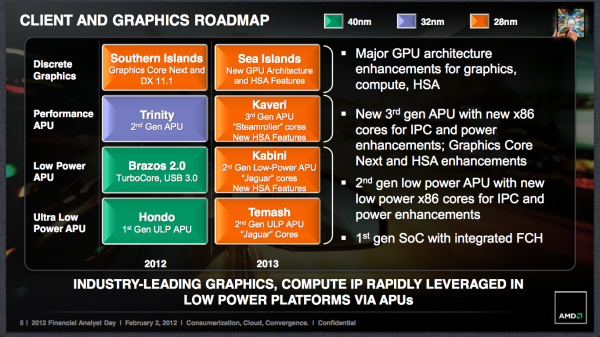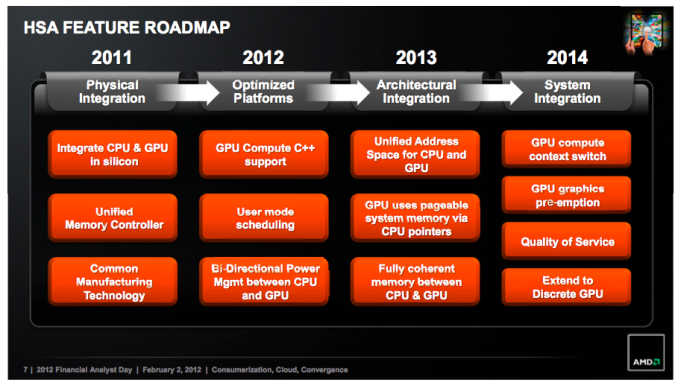AMD Radeon HD 7790 Review Feat. Sapphire: The First Desktop Sea Islands
by Ryan Smith on March 22, 2013 12:01 AM EST- Posted in
- GPUs
- AMD
- Sapphire
- GCN
- Radeon HD 7000
Bonaire’s Microarchitecture - What We’re Calling GCN 1.1
With our introduction out of the way, before looking at the cards and our performance results we would like to dive into a technical discussion and a bit of nitpicking. Specifically we would like to spend some time talking about architectures and product naming, as it’s going to be a bit confusing at first. As AMD has stated numerous times in the past, Graphics Core Next is a long-term architecture for the company. AMD intends to evolve GCN over the years, releasing multiple microarchitectures based on GCN that improve the architecture and add features while still being rooted in the design principles of GCN. GCN is after all the other half of AMD’s upcoming HSA-capable APUs, the culmination of years of AMD’s efforts with HSA/Fusion.
So where does Bonaire fit in? Bonaire is of course a GCN part; it’s a new microarchitecture that’s technically different from Southern Islands, but on the whole it’s a microarchitecture that’s extremely close in design to Southern Islands. In this new microarchitecture there are some changes – among other things the new microarchitecture implements some new instructions that will be useful for HSA, support for a larger number of compute work queues (also good for HSA) and it also implements a new version of AMD’s PowerTune technology (which we’ll get to in a bit) – but otherwise the differences from Southern Islands are very few. There are no notable changes in shader/CU efficiency, ROP efficiency, graphics features, etc. Unless you’re writing compute code for AMD GPUs, from what we know about this microarchitecture it’s likely you’d never notice a difference.
Unfortunately AMD has chosen to more-or-less gloss over the microarchitectural differences altogether, which is not wholly surprising since they will be selling Bonaire and previous generation products side-by-side. Bonaire’s microarchitecture has no official name (at least not one AMD wants to give us) and no version number. The Sea Islands name we’ve been seeing thrown around is not the microarchitecture name. Sea Islands is in fact the name for all of the GPUs in this wave – or perhaps it would be better to say all of the products created in this development cycle – including both Bonaire and it’s new microarchitecture, and Oland, AMD’s other new GPU primarily for mobile that is purely Southern Islands in microarchitecture.

In fact if not for the fact that AMD released (and then retracted) an ISA document called “AMD Sea Islands Instruction Set Architecture” last month, we would likely know even less about Bonaire’s microarchitecture. The document has been retracted at least in part due to the name (since AMD will not be calling the microarchitecture Sea Islands after all), so as a whole AMD isn’t particularly keen in talking about their microarchitecture at this time. But at the same time from a product standpoint it gives you an idea of how AMD is intending to smoothly offer both Southern Islands and Bonaire microarchitecture parts together as one product family.
Anyhow, for the sake of our sanity and for our discussions, in lieu of an official name from AMD we’re going to be retroactively renaming AMD’s GCN microarchitectures in order to quickly tell them apart. For the rest of this article and in future articles we will be referring to Southern Islands as GCN 1.0, while Bonaire’s microarchitecture will be GCN 1.1, to reflect the small changes between it and the first rendition of GCN.
Ultimately the differences between GCN 1.0 and GCN 1.1 are extremely minor, but they are real. But despite our general annoyance in how this has been handled, for consumers the difference between a GCN 1.0 card like the 7770 and a GCN 1.1 card like the 7790 should be limited to their innate performance differences, and of course PowerTune. GCN 1.1 or not, Bonaire fits in nicely in AMD’s current product stack and is in a position where it’s reasonable for it to be lumped together with GCN 1.0 parts as a single family. It’s really only the technical enthusiasts (like ourselves) and programmers that should have any significant reason to care about GCN 1.0 versus GCN 1.1. For everyone else this may just as well be another Southern Islands part.











107 Comments
View All Comments
bebimbap - Friday, March 22, 2013 - link
would it be wrong of me to wait for the 7790 ghz ed?SithSolo1 - Friday, March 22, 2013 - link
There will be no GE of this card.Quote - "The Radeon HD 7790 runs at 1GHz, but is not going to be called a "GHz Edition" anymore. AMD feels that they have made the point about having 1GHz edition GPUs in the market in 2012, and did not feel a need to label this new one a GHz Edition. Therefore, it will just be known as Radeon HD 7790." - Brent @ HardOCP, Asus DCUII 7790 review
SithSolo1 - Friday, March 22, 2013 - link
Before someone gets confused, I'm not Brent. I just happened to read the review a bit ago and remembered that part about the Ghz Edition.Hardcore69 - Friday, March 22, 2013 - link
Don't see a point. As a PC gamer I want it all, not some laughably compromised card - just over 30FPS (if that) at 1080p with the settings turned up? What's the point, just buy a console. I'll stick with my 680.cyan1d3 - Friday, March 22, 2013 - link
While I agree with your sentiment, this card was not designed with us in mind, there is a large portion of people on budgets, who can't go ahead and blow ~$450 on a graphics card. There is also a large portion of people who see no need to play games at Ultra with high AA, etc.This card is a great line-up filler. I can see a use for this in a variety of budget gaming systems.
R3MF - Monday, March 25, 2013 - link
agreed.i spent £400 on an MSI 7970 Lightning, but not everyone is that stupid! :D
evonitzer - Friday, March 22, 2013 - link
Well with a name like Hardcore69, of course you would want the best of the best of the best (with honors). But I'm a casual PC gamer, so this card looks pretty great to me. My 4870 is getting a little (ok, very) long in the tooth. Why would I buy a console and pay full price for games, only use a controller, and have to pay a monthly fee (x360) just to play casually when I could pick up a $150 card and drop it into my computer?CeriseCogburn - Sunday, March 24, 2013 - link
His point wasn't your pathetic budget, his point was the graphics suck like a console.Just keep the 4870, it sucks too.
I am as mad as hell - Friday, March 22, 2013 - link
The day will come, in the not so distant future, that 700W PS requirements or higher for high-end gaming machines will come to an end (thankfully). And the whole system will not consume more than 100W and fits inside a mATX case or smaller (and no need for Godzilla size cooling fans anymore either).CeriseCogburn - Sunday, March 24, 2013 - link
It's called Haswell.